Analysis of Breast Cancer Screening Program in Australia: A Report
VerifiedAdded on 2021/04/21
|10
|2292
|30
Report
AI Summary
This report examines the BreastScreen Australia program, a critical initiative for breast cancer screening. The program offers free mammography screening to women aged 40 and above, aiming to detect breast cancer early and reduce associated deaths and illnesses. The report highlights the prevalence of breast cancer in Australia, risk factors, and the impact of the screening program on morbidity and mortality. It discusses the effectiveness of mammography in early detection, particularly in women over 50, and the program's benefits in terms of breast cancer survival rates. The report also addresses the importance of regular screening, the participation rates, and the need for continued efforts to improve the program's reach, particularly among Indigenous Australians. Overall, the report underscores the significance of breast cancer screening as a vital public health strategy.
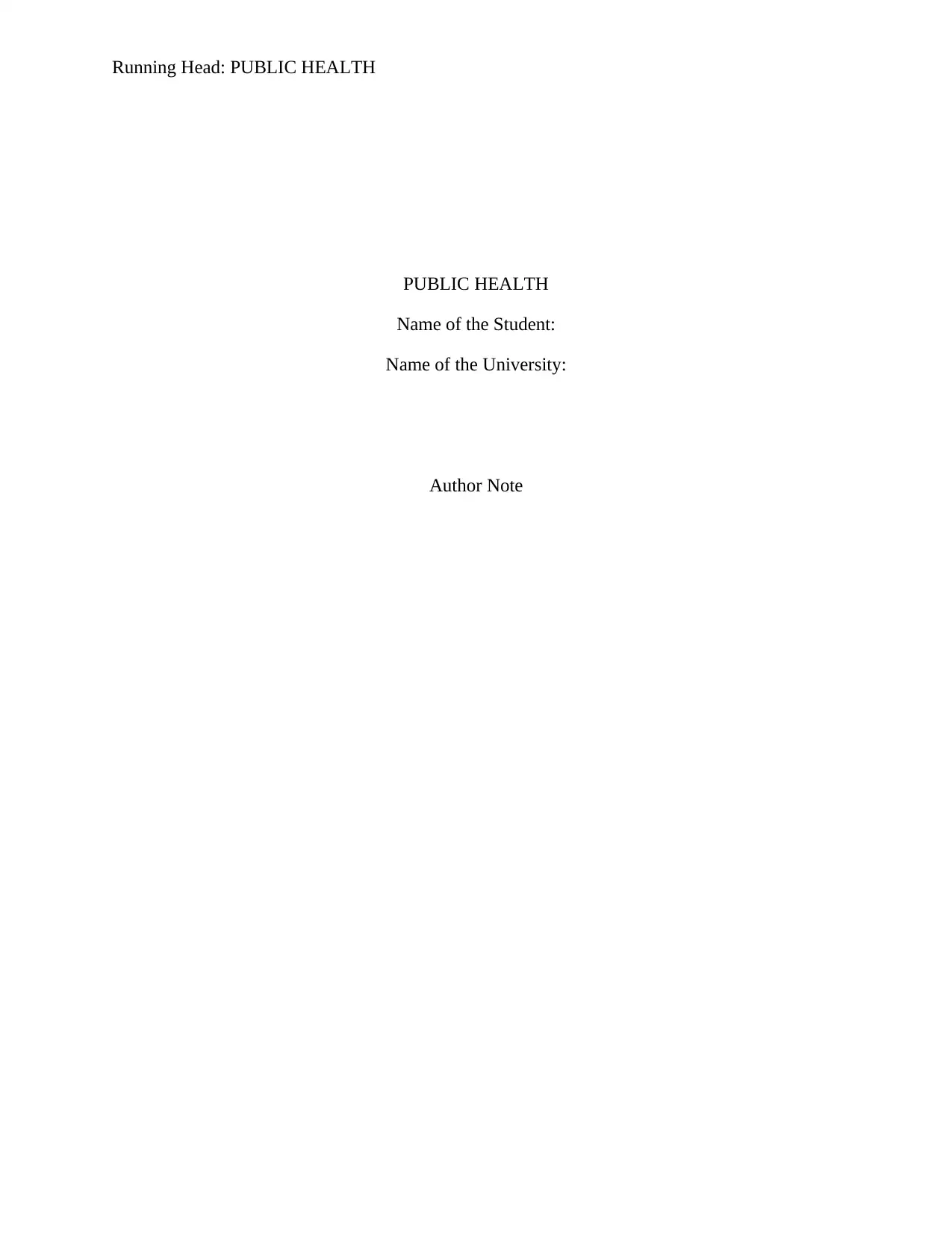
Running Head: PUBLIC HEALTH
PUBLIC HEALTH
Name of the Student:
Name of the University:
Author Note
PUBLIC HEALTH
Name of the Student:
Name of the University:
Author Note
Paraphrase This Document
Need a fresh take? Get an instant paraphrase of this document with our AI Paraphraser
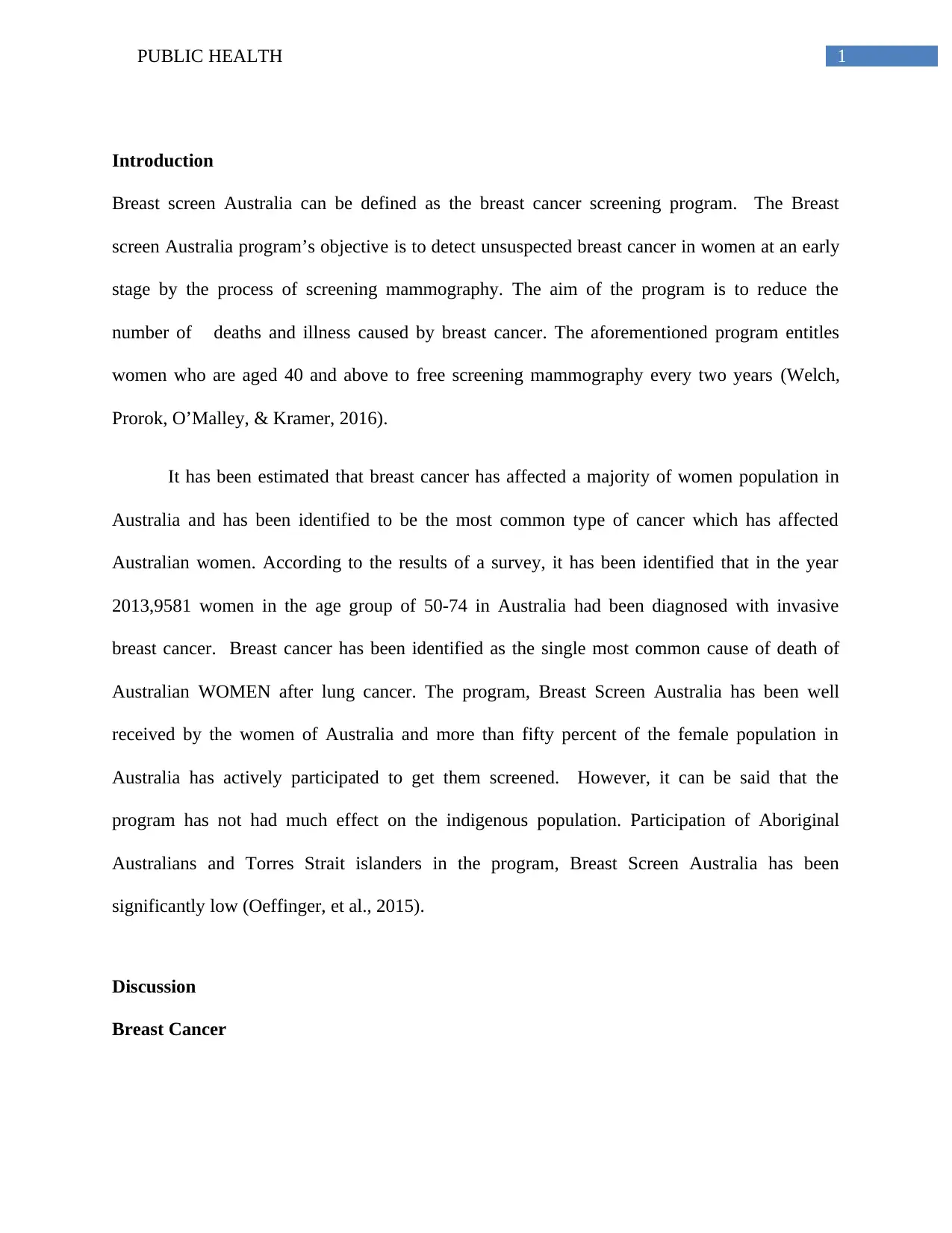
1PUBLIC HEALTH
Introduction
Breast screen Australia can be defined as the breast cancer screening program. The Breast
screen Australia program’s objective is to detect unsuspected breast cancer in women at an early
stage by the process of screening mammography. The aim of the program is to reduce the
number of deaths and illness caused by breast cancer. The aforementioned program entitles
women who are aged 40 and above to free screening mammography every two years (Welch,
Prorok, O’Malley, & Kramer, 2016).
It has been estimated that breast cancer has affected a majority of women population in
Australia and has been identified to be the most common type of cancer which has affected
Australian women. According to the results of a survey, it has been identified that in the year
2013,9581 women in the age group of 50-74 in Australia had been diagnosed with invasive
breast cancer. Breast cancer has been identified as the single most common cause of death of
Australian WOMEN after lung cancer. The program, Breast Screen Australia has been well
received by the women of Australia and more than fifty percent of the female population in
Australia has actively participated to get them screened. However, it can be said that the
program has not had much effect on the indigenous population. Participation of Aboriginal
Australians and Torres Strait islanders in the program, Breast Screen Australia has been
significantly low (Oeffinger, et al., 2015).
Discussion
Breast Cancer
Introduction
Breast screen Australia can be defined as the breast cancer screening program. The Breast
screen Australia program’s objective is to detect unsuspected breast cancer in women at an early
stage by the process of screening mammography. The aim of the program is to reduce the
number of deaths and illness caused by breast cancer. The aforementioned program entitles
women who are aged 40 and above to free screening mammography every two years (Welch,
Prorok, O’Malley, & Kramer, 2016).
It has been estimated that breast cancer has affected a majority of women population in
Australia and has been identified to be the most common type of cancer which has affected
Australian women. According to the results of a survey, it has been identified that in the year
2013,9581 women in the age group of 50-74 in Australia had been diagnosed with invasive
breast cancer. Breast cancer has been identified as the single most common cause of death of
Australian WOMEN after lung cancer. The program, Breast Screen Australia has been well
received by the women of Australia and more than fifty percent of the female population in
Australia has actively participated to get them screened. However, it can be said that the
program has not had much effect on the indigenous population. Participation of Aboriginal
Australians and Torres Strait islanders in the program, Breast Screen Australia has been
significantly low (Oeffinger, et al., 2015).
Discussion
Breast Cancer
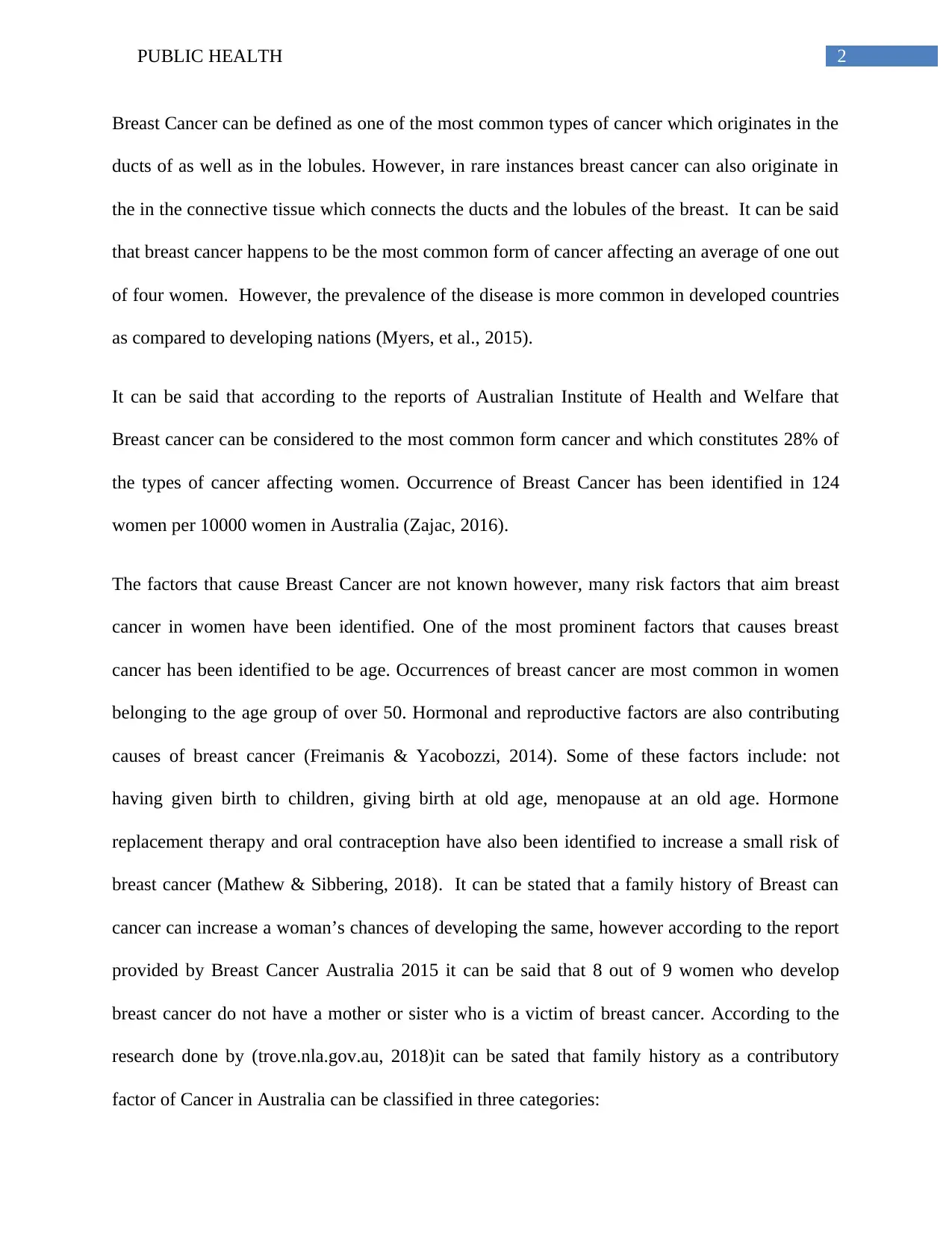
2PUBLIC HEALTH
Breast Cancer can be defined as one of the most common types of cancer which originates in the
ducts of as well as in the lobules. However, in rare instances breast cancer can also originate in
the in the connective tissue which connects the ducts and the lobules of the breast. It can be said
that breast cancer happens to be the most common form of cancer affecting an average of one out
of four women. However, the prevalence of the disease is more common in developed countries
as compared to developing nations (Myers, et al., 2015).
It can be said that according to the reports of Australian Institute of Health and Welfare that
Breast cancer can be considered to the most common form cancer and which constitutes 28% of
the types of cancer affecting women. Occurrence of Breast Cancer has been identified in 124
women per 10000 women in Australia (Zajac, 2016).
The factors that cause Breast Cancer are not known however, many risk factors that aim breast
cancer in women have been identified. One of the most prominent factors that causes breast
cancer has been identified to be age. Occurrences of breast cancer are most common in women
belonging to the age group of over 50. Hormonal and reproductive factors are also contributing
causes of breast cancer (Freimanis & Yacobozzi, 2014). Some of these factors include: not
having given birth to children, giving birth at old age, menopause at an old age. Hormone
replacement therapy and oral contraception have also been identified to increase a small risk of
breast cancer (Mathew & Sibbering, 2018). It can be stated that a family history of Breast can
cancer can increase a woman’s chances of developing the same, however according to the report
provided by Breast Cancer Australia 2015 it can be said that 8 out of 9 women who develop
breast cancer do not have a mother or sister who is a victim of breast cancer. According to the
research done by (trove.nla.gov.au, 2018)it can be sated that family history as a contributory
factor of Cancer in Australia can be classified in three categories:
Breast Cancer can be defined as one of the most common types of cancer which originates in the
ducts of as well as in the lobules. However, in rare instances breast cancer can also originate in
the in the connective tissue which connects the ducts and the lobules of the breast. It can be said
that breast cancer happens to be the most common form of cancer affecting an average of one out
of four women. However, the prevalence of the disease is more common in developed countries
as compared to developing nations (Myers, et al., 2015).
It can be said that according to the reports of Australian Institute of Health and Welfare that
Breast cancer can be considered to the most common form cancer and which constitutes 28% of
the types of cancer affecting women. Occurrence of Breast Cancer has been identified in 124
women per 10000 women in Australia (Zajac, 2016).
The factors that cause Breast Cancer are not known however, many risk factors that aim breast
cancer in women have been identified. One of the most prominent factors that causes breast
cancer has been identified to be age. Occurrences of breast cancer are most common in women
belonging to the age group of over 50. Hormonal and reproductive factors are also contributing
causes of breast cancer (Freimanis & Yacobozzi, 2014). Some of these factors include: not
having given birth to children, giving birth at old age, menopause at an old age. Hormone
replacement therapy and oral contraception have also been identified to increase a small risk of
breast cancer (Mathew & Sibbering, 2018). It can be stated that a family history of Breast can
cancer can increase a woman’s chances of developing the same, however according to the report
provided by Breast Cancer Australia 2015 it can be said that 8 out of 9 women who develop
breast cancer do not have a mother or sister who is a victim of breast cancer. According to the
research done by (trove.nla.gov.au, 2018)it can be sated that family history as a contributory
factor of Cancer in Australia can be classified in three categories:
⊘ This is a preview!⊘
Do you want full access?
Subscribe today to unlock all pages.

Trusted by 1+ million students worldwide
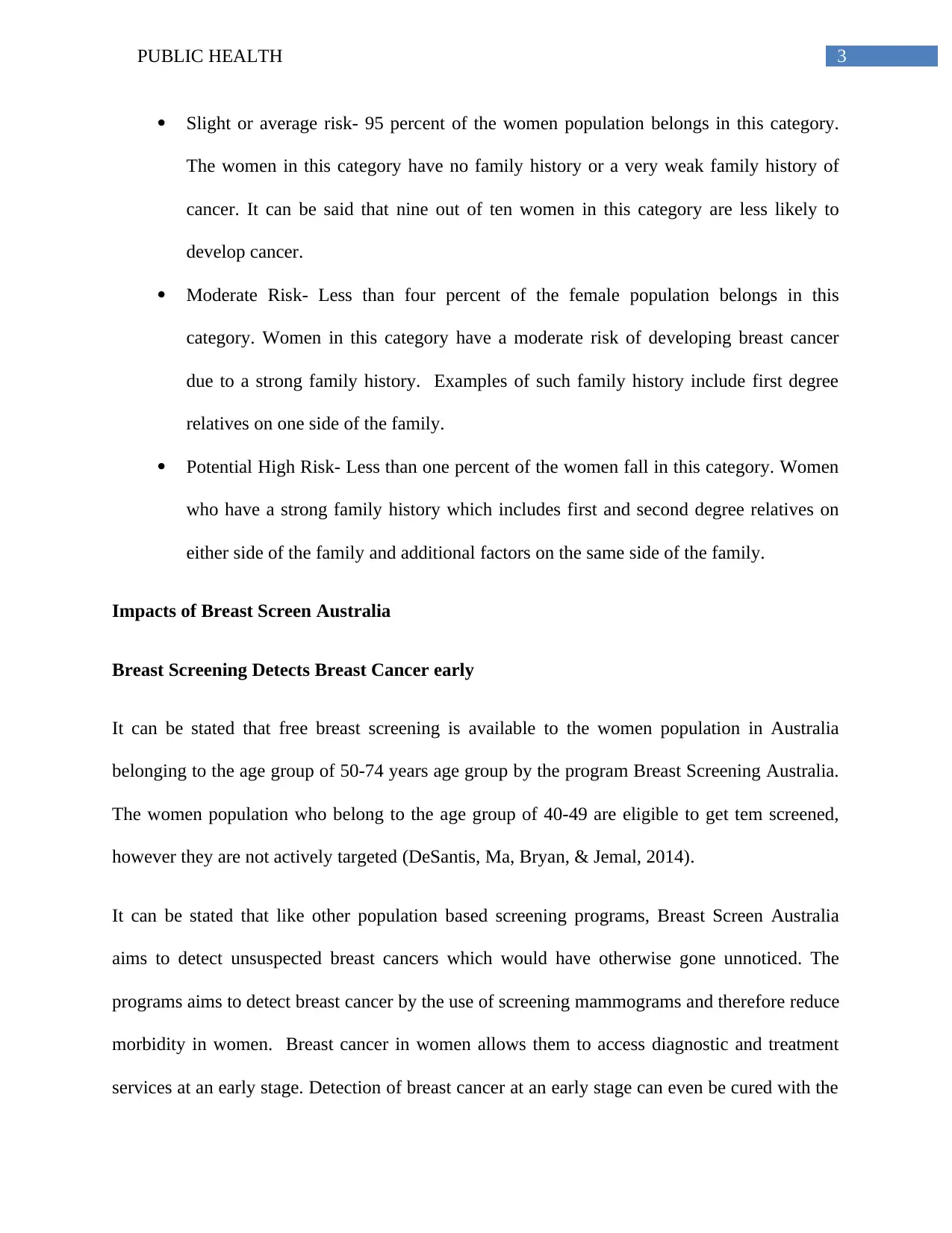
3PUBLIC HEALTH
Slight or average risk- 95 percent of the women population belongs in this category.
The women in this category have no family history or a very weak family history of
cancer. It can be said that nine out of ten women in this category are less likely to
develop cancer.
Moderate Risk- Less than four percent of the female population belongs in this
category. Women in this category have a moderate risk of developing breast cancer
due to a strong family history. Examples of such family history include first degree
relatives on one side of the family.
Potential High Risk- Less than one percent of the women fall in this category. Women
who have a strong family history which includes first and second degree relatives on
either side of the family and additional factors on the same side of the family.
Impacts of Breast Screen Australia
Breast Screening Detects Breast Cancer early
It can be stated that free breast screening is available to the women population in Australia
belonging to the age group of 50-74 years age group by the program Breast Screening Australia.
The women population who belong to the age group of 40-49 are eligible to get tem screened,
however they are not actively targeted (DeSantis, Ma, Bryan, & Jemal, 2014).
It can be stated that like other population based screening programs, Breast Screen Australia
aims to detect unsuspected breast cancers which would have otherwise gone unnoticed. The
programs aims to detect breast cancer by the use of screening mammograms and therefore reduce
morbidity in women. Breast cancer in women allows them to access diagnostic and treatment
services at an early stage. Detection of breast cancer at an early stage can even be cured with the
Slight or average risk- 95 percent of the women population belongs in this category.
The women in this category have no family history or a very weak family history of
cancer. It can be said that nine out of ten women in this category are less likely to
develop cancer.
Moderate Risk- Less than four percent of the female population belongs in this
category. Women in this category have a moderate risk of developing breast cancer
due to a strong family history. Examples of such family history include first degree
relatives on one side of the family.
Potential High Risk- Less than one percent of the women fall in this category. Women
who have a strong family history which includes first and second degree relatives on
either side of the family and additional factors on the same side of the family.
Impacts of Breast Screen Australia
Breast Screening Detects Breast Cancer early
It can be stated that free breast screening is available to the women population in Australia
belonging to the age group of 50-74 years age group by the program Breast Screening Australia.
The women population who belong to the age group of 40-49 are eligible to get tem screened,
however they are not actively targeted (DeSantis, Ma, Bryan, & Jemal, 2014).
It can be stated that like other population based screening programs, Breast Screen Australia
aims to detect unsuspected breast cancers which would have otherwise gone unnoticed. The
programs aims to detect breast cancer by the use of screening mammograms and therefore reduce
morbidity in women. Breast cancer in women allows them to access diagnostic and treatment
services at an early stage. Detection of breast cancer at an early stage can even be cured with the
Paraphrase This Document
Need a fresh take? Get an instant paraphrase of this document with our AI Paraphraser
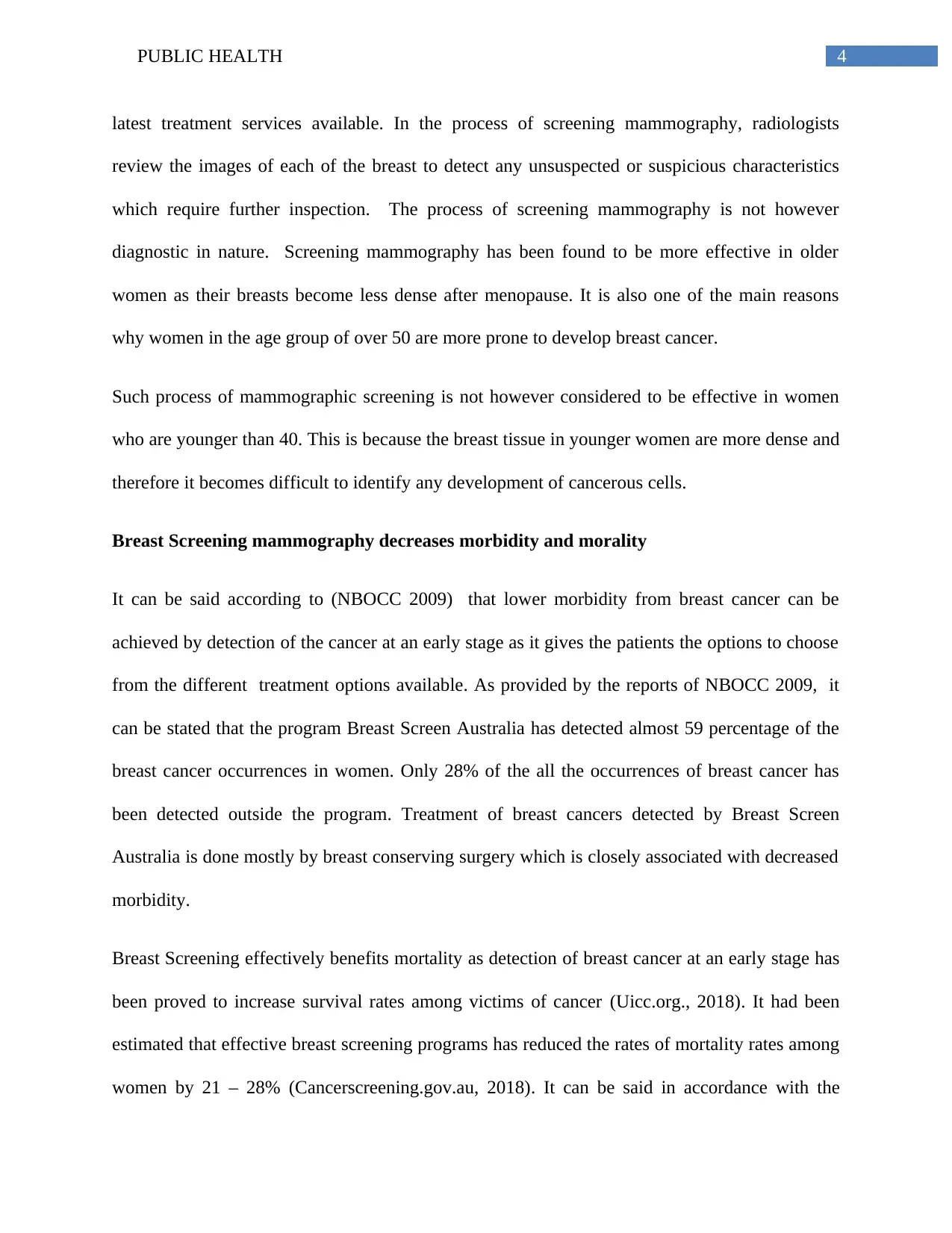
4PUBLIC HEALTH
latest treatment services available. In the process of screening mammography, radiologists
review the images of each of the breast to detect any unsuspected or suspicious characteristics
which require further inspection. The process of screening mammography is not however
diagnostic in nature. Screening mammography has been found to be more effective in older
women as their breasts become less dense after menopause. It is also one of the main reasons
why women in the age group of over 50 are more prone to develop breast cancer.
Such process of mammographic screening is not however considered to be effective in women
who are younger than 40. This is because the breast tissue in younger women are more dense and
therefore it becomes difficult to identify any development of cancerous cells.
Breast Screening mammography decreases morbidity and morality
It can be said according to (NBOCC 2009) that lower morbidity from breast cancer can be
achieved by detection of the cancer at an early stage as it gives the patients the options to choose
from the different treatment options available. As provided by the reports of NBOCC 2009, it
can be stated that the program Breast Screen Australia has detected almost 59 percentage of the
breast cancer occurrences in women. Only 28% of the all the occurrences of breast cancer has
been detected outside the program. Treatment of breast cancers detected by Breast Screen
Australia is done mostly by breast conserving surgery which is closely associated with decreased
morbidity.
Breast Screening effectively benefits mortality as detection of breast cancer at an early stage has
been proved to increase survival rates among victims of cancer (Uicc.org., 2018). It had been
estimated that effective breast screening programs has reduced the rates of mortality rates among
women by 21 – 28% (Cancerscreening.gov.au, 2018). It can be said in accordance with the
latest treatment services available. In the process of screening mammography, radiologists
review the images of each of the breast to detect any unsuspected or suspicious characteristics
which require further inspection. The process of screening mammography is not however
diagnostic in nature. Screening mammography has been found to be more effective in older
women as their breasts become less dense after menopause. It is also one of the main reasons
why women in the age group of over 50 are more prone to develop breast cancer.
Such process of mammographic screening is not however considered to be effective in women
who are younger than 40. This is because the breast tissue in younger women are more dense and
therefore it becomes difficult to identify any development of cancerous cells.
Breast Screening mammography decreases morbidity and morality
It can be said according to (NBOCC 2009) that lower morbidity from breast cancer can be
achieved by detection of the cancer at an early stage as it gives the patients the options to choose
from the different treatment options available. As provided by the reports of NBOCC 2009, it
can be stated that the program Breast Screen Australia has detected almost 59 percentage of the
breast cancer occurrences in women. Only 28% of the all the occurrences of breast cancer has
been detected outside the program. Treatment of breast cancers detected by Breast Screen
Australia is done mostly by breast conserving surgery which is closely associated with decreased
morbidity.
Breast Screening effectively benefits mortality as detection of breast cancer at an early stage has
been proved to increase survival rates among victims of cancer (Uicc.org., 2018). It had been
estimated that effective breast screening programs has reduced the rates of mortality rates among
women by 21 – 28% (Cancerscreening.gov.au, 2018). It can be said in accordance with the
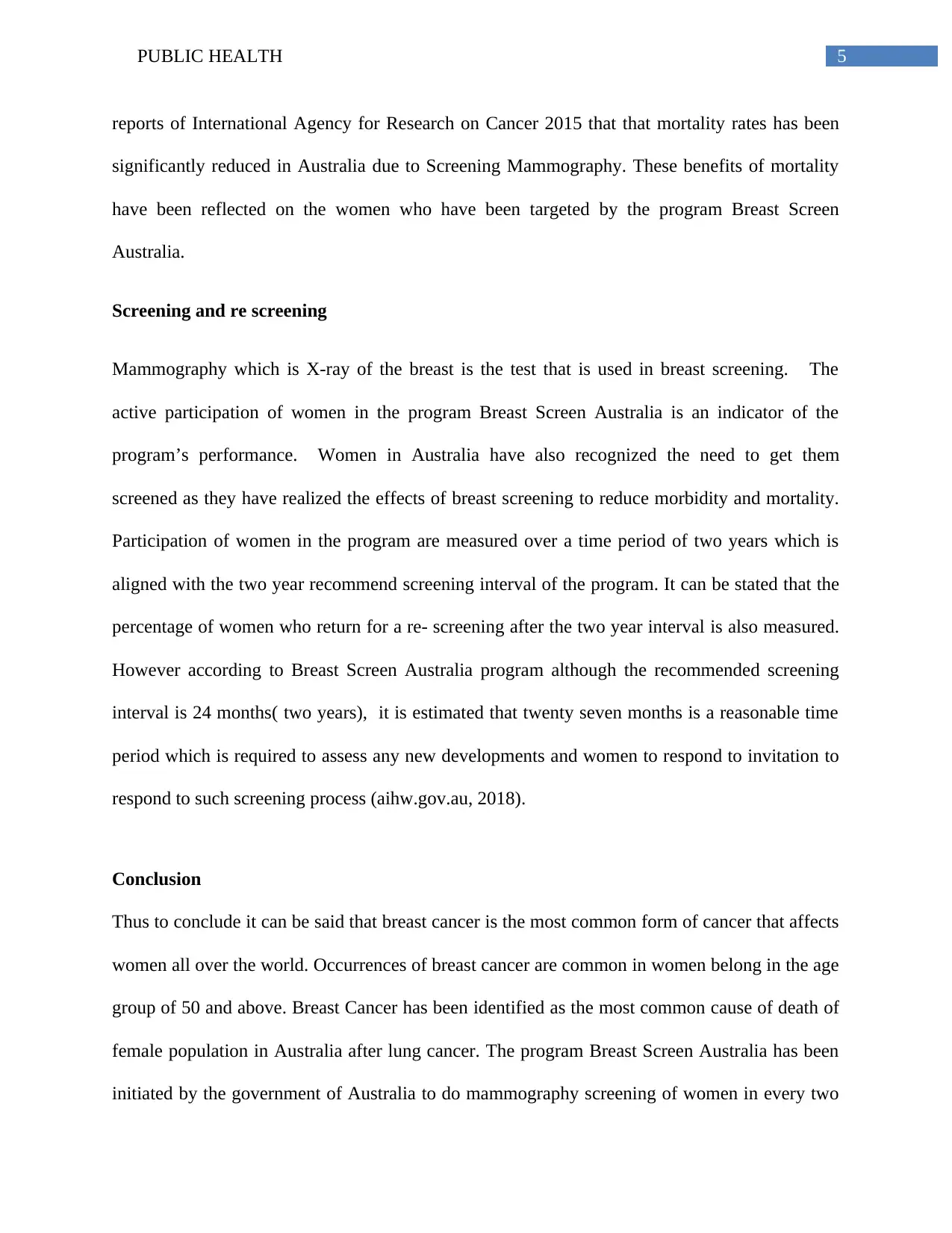
5PUBLIC HEALTH
reports of International Agency for Research on Cancer 2015 that that mortality rates has been
significantly reduced in Australia due to Screening Mammography. These benefits of mortality
have been reflected on the women who have been targeted by the program Breast Screen
Australia.
Screening and re screening
Mammography which is X-ray of the breast is the test that is used in breast screening. The
active participation of women in the program Breast Screen Australia is an indicator of the
program’s performance. Women in Australia have also recognized the need to get them
screened as they have realized the effects of breast screening to reduce morbidity and mortality.
Participation of women in the program are measured over a time period of two years which is
aligned with the two year recommend screening interval of the program. It can be stated that the
percentage of women who return for a re- screening after the two year interval is also measured.
However according to Breast Screen Australia program although the recommended screening
interval is 24 months( two years), it is estimated that twenty seven months is a reasonable time
period which is required to assess any new developments and women to respond to invitation to
respond to such screening process (aihw.gov.au, 2018).
Conclusion
Thus to conclude it can be said that breast cancer is the most common form of cancer that affects
women all over the world. Occurrences of breast cancer are common in women belong in the age
group of 50 and above. Breast Cancer has been identified as the most common cause of death of
female population in Australia after lung cancer. The program Breast Screen Australia has been
initiated by the government of Australia to do mammography screening of women in every two
reports of International Agency for Research on Cancer 2015 that that mortality rates has been
significantly reduced in Australia due to Screening Mammography. These benefits of mortality
have been reflected on the women who have been targeted by the program Breast Screen
Australia.
Screening and re screening
Mammography which is X-ray of the breast is the test that is used in breast screening. The
active participation of women in the program Breast Screen Australia is an indicator of the
program’s performance. Women in Australia have also recognized the need to get them
screened as they have realized the effects of breast screening to reduce morbidity and mortality.
Participation of women in the program are measured over a time period of two years which is
aligned with the two year recommend screening interval of the program. It can be stated that the
percentage of women who return for a re- screening after the two year interval is also measured.
However according to Breast Screen Australia program although the recommended screening
interval is 24 months( two years), it is estimated that twenty seven months is a reasonable time
period which is required to assess any new developments and women to respond to invitation to
respond to such screening process (aihw.gov.au, 2018).
Conclusion
Thus to conclude it can be said that breast cancer is the most common form of cancer that affects
women all over the world. Occurrences of breast cancer are common in women belong in the age
group of 50 and above. Breast Cancer has been identified as the most common cause of death of
female population in Australia after lung cancer. The program Breast Screen Australia has been
initiated by the government of Australia to do mammography screening of women in every two
⊘ This is a preview!⊘
Do you want full access?
Subscribe today to unlock all pages.

Trusted by 1+ million students worldwide
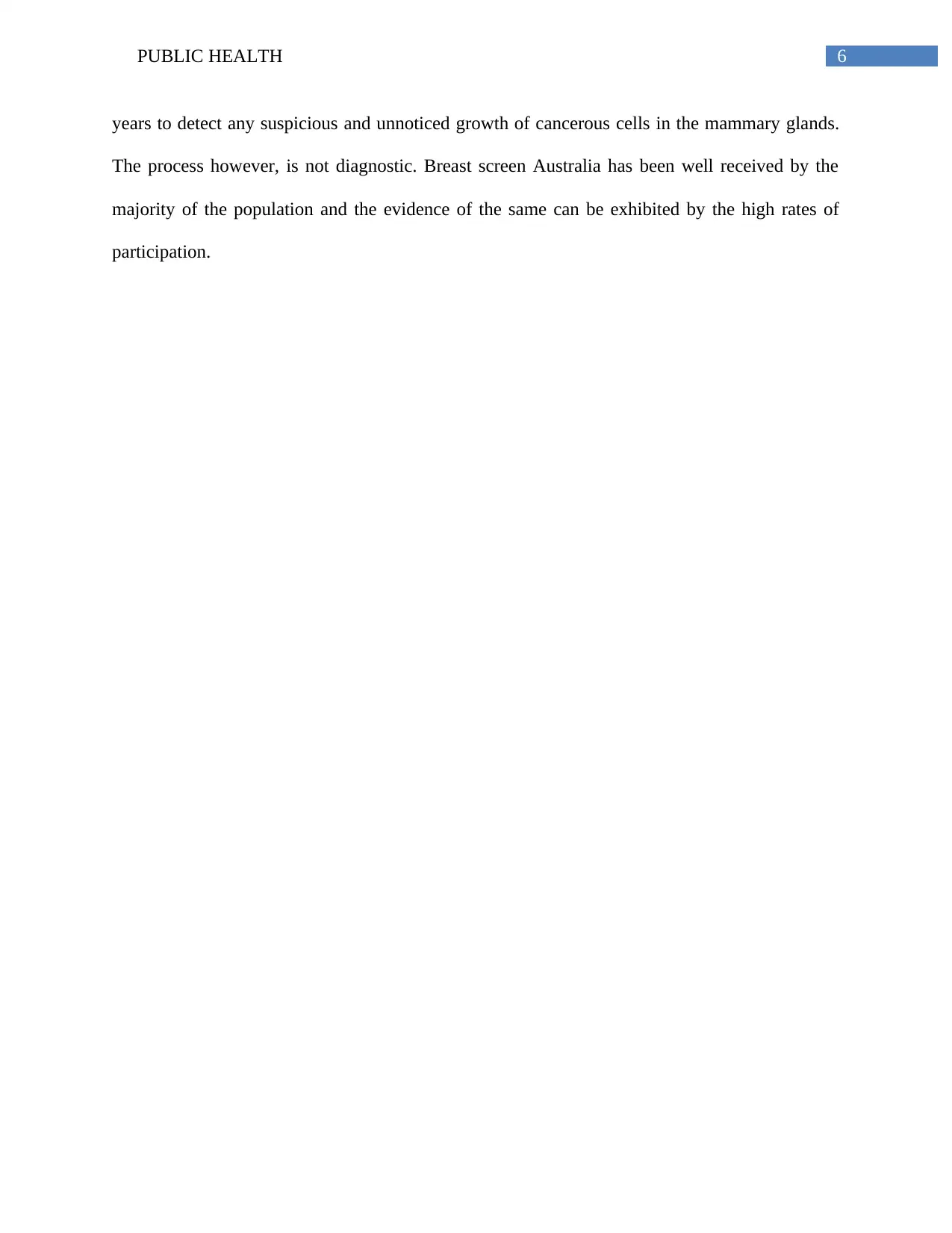
6PUBLIC HEALTH
years to detect any suspicious and unnoticed growth of cancerous cells in the mammary glands.
The process however, is not diagnostic. Breast screen Australia has been well received by the
majority of the population and the evidence of the same can be exhibited by the high rates of
participation.
years to detect any suspicious and unnoticed growth of cancerous cells in the mammary glands.
The process however, is not diagnostic. Breast screen Australia has been well received by the
majority of the population and the evidence of the same can be exhibited by the high rates of
participation.
Paraphrase This Document
Need a fresh take? Get an instant paraphrase of this document with our AI Paraphraser
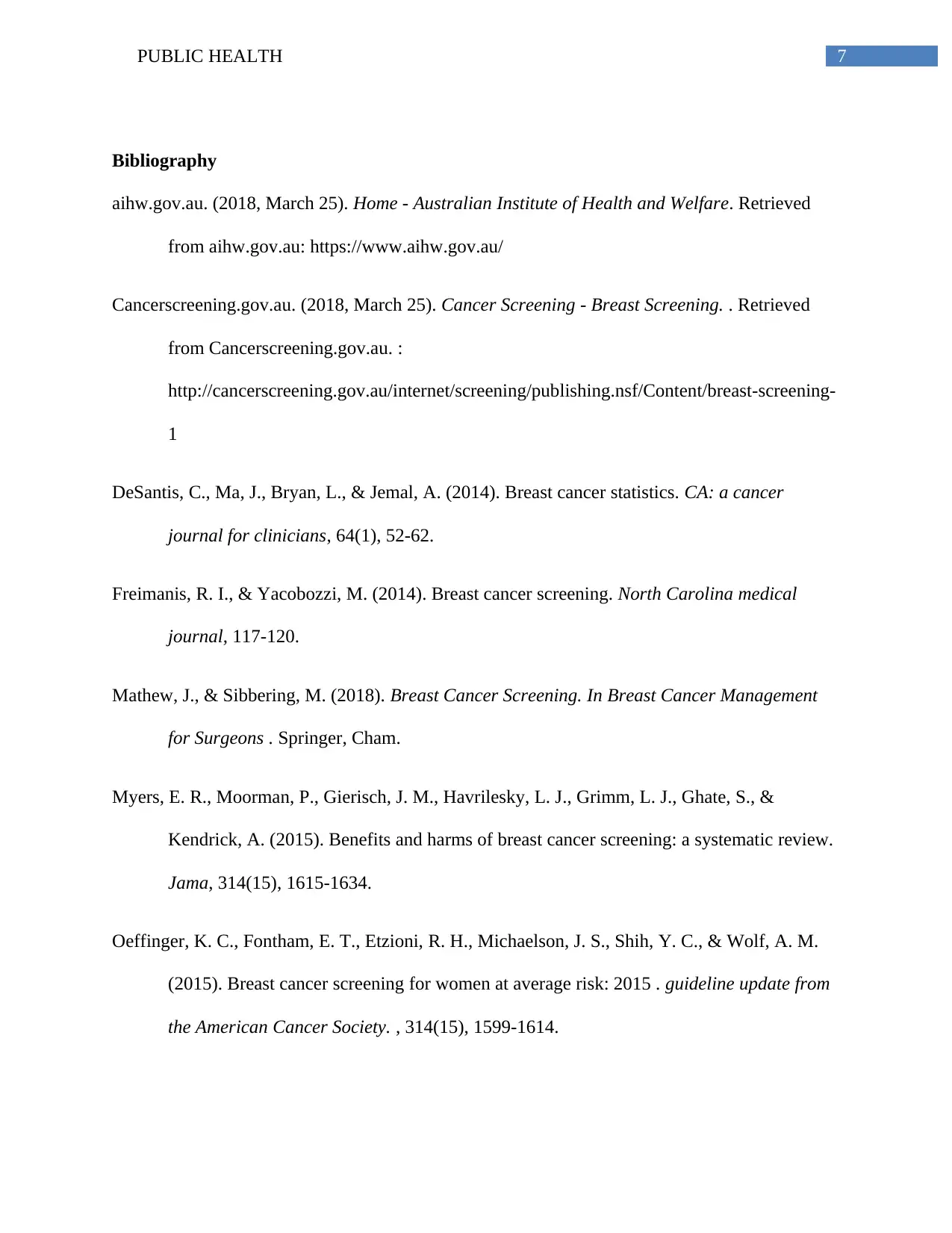
7PUBLIC HEALTH
Bibliography
aihw.gov.au. (2018, March 25). Home - Australian Institute of Health and Welfare. Retrieved
from aihw.gov.au: https://www.aihw.gov.au/
Cancerscreening.gov.au. (2018, March 25). Cancer Screening - Breast Screening. . Retrieved
from Cancerscreening.gov.au. :
http://cancerscreening.gov.au/internet/screening/publishing.nsf/Content/breast-screening-
1
DeSantis, C., Ma, J., Bryan, L., & Jemal, A. (2014). Breast cancer statistics. CA: a cancer
journal for clinicians, 64(1), 52-62.
Freimanis, R. I., & Yacobozzi, M. (2014). Breast cancer screening. North Carolina medical
journal, 117-120.
Mathew, J., & Sibbering, M. (2018). Breast Cancer Screening. In Breast Cancer Management
for Surgeons . Springer, Cham.
Myers, E. R., Moorman, P., Gierisch, J. M., Havrilesky, L. J., Grimm, L. J., Ghate, S., &
Kendrick, A. (2015). Benefits and harms of breast cancer screening: a systematic review.
Jama, 314(15), 1615-1634.
Oeffinger, K. C., Fontham, E. T., Etzioni, R. H., Michaelson, J. S., Shih, Y. C., & Wolf, A. M.
(2015). Breast cancer screening for women at average risk: 2015 . guideline update from
the American Cancer Society. , 314(15), 1599-1614.
Bibliography
aihw.gov.au. (2018, March 25). Home - Australian Institute of Health and Welfare. Retrieved
from aihw.gov.au: https://www.aihw.gov.au/
Cancerscreening.gov.au. (2018, March 25). Cancer Screening - Breast Screening. . Retrieved
from Cancerscreening.gov.au. :
http://cancerscreening.gov.au/internet/screening/publishing.nsf/Content/breast-screening-
1
DeSantis, C., Ma, J., Bryan, L., & Jemal, A. (2014). Breast cancer statistics. CA: a cancer
journal for clinicians, 64(1), 52-62.
Freimanis, R. I., & Yacobozzi, M. (2014). Breast cancer screening. North Carolina medical
journal, 117-120.
Mathew, J., & Sibbering, M. (2018). Breast Cancer Screening. In Breast Cancer Management
for Surgeons . Springer, Cham.
Myers, E. R., Moorman, P., Gierisch, J. M., Havrilesky, L. J., Grimm, L. J., Ghate, S., &
Kendrick, A. (2015). Benefits and harms of breast cancer screening: a systematic review.
Jama, 314(15), 1615-1634.
Oeffinger, K. C., Fontham, E. T., Etzioni, R. H., Michaelson, J. S., Shih, Y. C., & Wolf, A. M.
(2015). Breast cancer screening for women at average risk: 2015 . guideline update from
the American Cancer Society. , 314(15), 1599-1614.
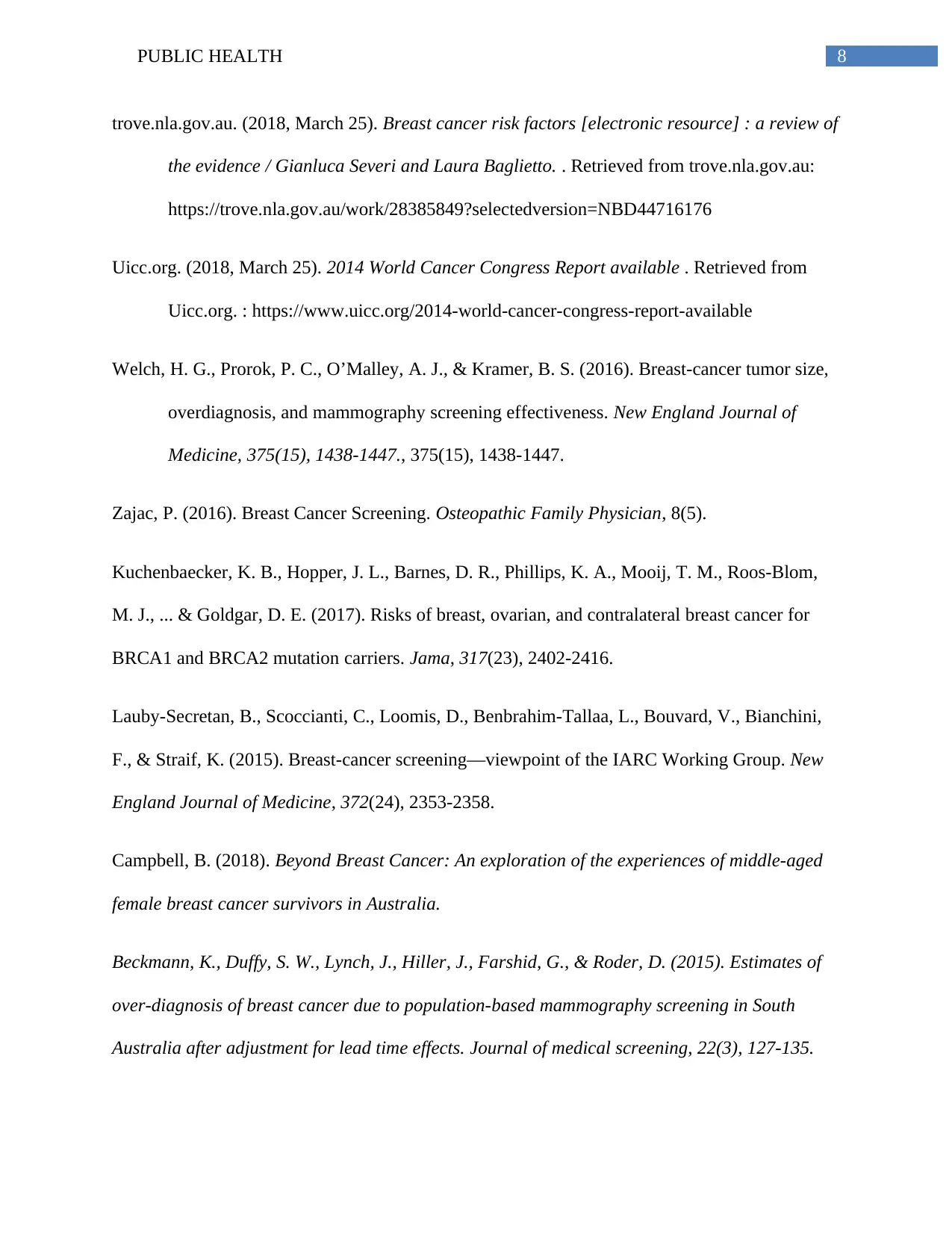
8PUBLIC HEALTH
trove.nla.gov.au. (2018, March 25). Breast cancer risk factors [electronic resource] : a review of
the evidence / Gianluca Severi and Laura Baglietto. . Retrieved from trove.nla.gov.au:
https://trove.nla.gov.au/work/28385849?selectedversion=NBD44716176
Uicc.org. (2018, March 25). 2014 World Cancer Congress Report available . Retrieved from
Uicc.org. : https://www.uicc.org/2014-world-cancer-congress-report-available
Welch, H. G., Prorok, P. C., O’Malley, A. J., & Kramer, B. S. (2016). Breast-cancer tumor size,
overdiagnosis, and mammography screening effectiveness. New England Journal of
Medicine, 375(15), 1438-1447., 375(15), 1438-1447.
Zajac, P. (2016). Breast Cancer Screening. Osteopathic Family Physician, 8(5).
Kuchenbaecker, K. B., Hopper, J. L., Barnes, D. R., Phillips, K. A., Mooij, T. M., Roos-Blom,
M. J., ... & Goldgar, D. E. (2017). Risks of breast, ovarian, and contralateral breast cancer for
BRCA1 and BRCA2 mutation carriers. Jama, 317(23), 2402-2416.
Lauby-Secretan, B., Scoccianti, C., Loomis, D., Benbrahim-Tallaa, L., Bouvard, V., Bianchini,
F., & Straif, K. (2015). Breast-cancer screening—viewpoint of the IARC Working Group. New
England Journal of Medicine, 372(24), 2353-2358.
Campbell, B. (2018). Beyond Breast Cancer: An exploration of the experiences of middle-aged
female breast cancer survivors in Australia.
Beckmann, K., Duffy, S. W., Lynch, J., Hiller, J., Farshid, G., & Roder, D. (2015). Estimates of
over-diagnosis of breast cancer due to population-based mammography screening in South
Australia after adjustment for lead time effects. Journal of medical screening, 22(3), 127-135.
trove.nla.gov.au. (2018, March 25). Breast cancer risk factors [electronic resource] : a review of
the evidence / Gianluca Severi and Laura Baglietto. . Retrieved from trove.nla.gov.au:
https://trove.nla.gov.au/work/28385849?selectedversion=NBD44716176
Uicc.org. (2018, March 25). 2014 World Cancer Congress Report available . Retrieved from
Uicc.org. : https://www.uicc.org/2014-world-cancer-congress-report-available
Welch, H. G., Prorok, P. C., O’Malley, A. J., & Kramer, B. S. (2016). Breast-cancer tumor size,
overdiagnosis, and mammography screening effectiveness. New England Journal of
Medicine, 375(15), 1438-1447., 375(15), 1438-1447.
Zajac, P. (2016). Breast Cancer Screening. Osteopathic Family Physician, 8(5).
Kuchenbaecker, K. B., Hopper, J. L., Barnes, D. R., Phillips, K. A., Mooij, T. M., Roos-Blom,
M. J., ... & Goldgar, D. E. (2017). Risks of breast, ovarian, and contralateral breast cancer for
BRCA1 and BRCA2 mutation carriers. Jama, 317(23), 2402-2416.
Lauby-Secretan, B., Scoccianti, C., Loomis, D., Benbrahim-Tallaa, L., Bouvard, V., Bianchini,
F., & Straif, K. (2015). Breast-cancer screening—viewpoint of the IARC Working Group. New
England Journal of Medicine, 372(24), 2353-2358.
Campbell, B. (2018). Beyond Breast Cancer: An exploration of the experiences of middle-aged
female breast cancer survivors in Australia.
Beckmann, K., Duffy, S. W., Lynch, J., Hiller, J., Farshid, G., & Roder, D. (2015). Estimates of
over-diagnosis of breast cancer due to population-based mammography screening in South
Australia after adjustment for lead time effects. Journal of medical screening, 22(3), 127-135.
⊘ This is a preview!⊘
Do you want full access?
Subscribe today to unlock all pages.

Trusted by 1+ million students worldwide
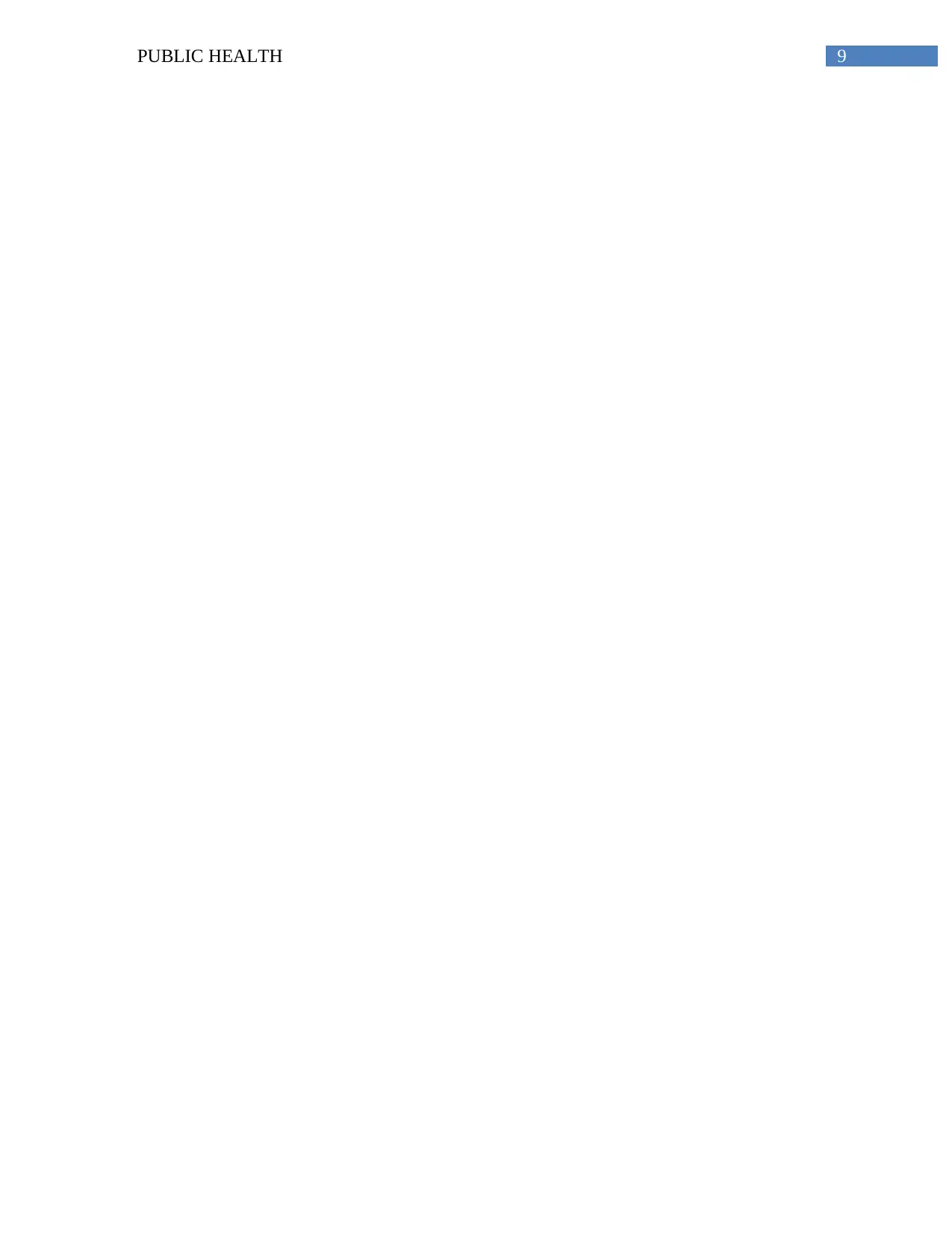
9PUBLIC HEALTH
1 out of 10
Related Documents
Your All-in-One AI-Powered Toolkit for Academic Success.
+13062052269
info@desklib.com
Available 24*7 on WhatsApp / Email
![[object Object]](/_next/static/media/star-bottom.7253800d.svg)
Unlock your academic potential
Copyright © 2020–2025 A2Z Services. All Rights Reserved. Developed and managed by ZUCOL.




